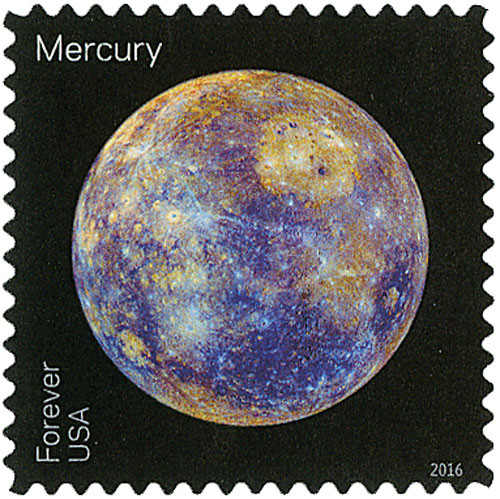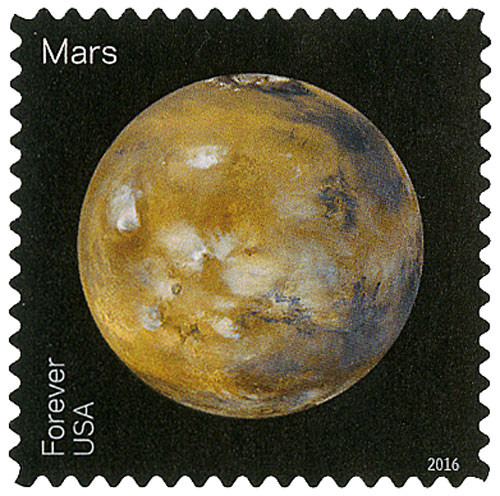
# 5070 - 2016 First-Class Forever Stamp - Views of Our Planets: Venus
US #5070
2016 Venus – Views of Our Planets
- Pictures Venus, the second planet from the Sun
- One of 8 stamps issued alongside the 2016 Pluto Explored stamps to commemorate space exploration in our Solar System and New Horizon spacecraft’s flyby of Pluton in 2015
Stamp Category: Commemorative
Set: Views of Our Planets
Value: 47¢ First Class Mail Rate (Forever)
First Day of Issue: May 31, 2016
First Day City: New York, New York
Quantity Issued: 40,000,000
Printed by: Ashton Potter (USA) Ltd.
Printing Method: Offset
Format: Panes of 16
Tagging: Nonphosphored type III, spot tag
Why the stamp was issued: To showcase Venus, the second planet from the Sun, and the NASA efforts that have allowed us to see this planet up-close. To honor NASA’s space exploration efforts within our Solar System that have given us up-close images of every plant and – as of 2015 – dwarf planet Pluto.
About the stamp designs: Pictures an image of Venus from NASA Jet Propulsion Laboratory at Caltech.
First Day City: The First Day of Issue Ceremony was held at the Javits Center in New York City during the World Stamp Show 2016.
About the Views of Our Planets set: Eight stamps issued to honor NASA’s space exploration efforts within our Solar System that have given us up-close images of every planet and – as of 2015 – dwarf planet Pluto. Each stamp pictures one planet in our Solar System. According to the USPS, “Some show the planet’s ‘true’ color – what we might see with our own eyes if traveling through space. Others use colors to represent and visualize certain features of a planet based on imaging data. Still others use the near-infrared spectrum to show things that cannot be seen by the human eye in visible light.”
History the stamp represents: The planet closest to Earth (Venus) shines brightest in our sky at night. This led the Ancient Romans to name it after their goddess of love and beauty.
Venus is sometimes called Earth’s “sister planet.” Their size, mass, density, composition, gravity, and distance from the Sun are all similar. But the ways in which they differ are quite extreme. Though it’s the second planet from the Sun, Venus is the hottest. Its thick, spinning atmosphere, which is filled with carbon dioxide and sulfuric acid, locks in temperatures of 880 degrees Fahrenheit.
Venus’s clouds are highly reflective (the reason it shines so bright in our sky) which made studying the planet’s surface a challenge. Yet, in 1962, Venus was the first planet explored in our solar system. The 1970 Venera 7 mission to Venus then became the first to land a spacecraft on another planet. Finally, in the 1990s, the Magellan probe used radar to provide the first images of Venus’s surface. The photos revealed a planet covered with more than 1,000 volcanoes, some of which could still be active today.
Venus differs from Earth, and most of the planets, in that it rotates clockwise. Scientists speculate that Venus once spun in the same direction as Earth, but was struck by a large object, flipping the planet upside down, so it spins in the same direction but appears reversed.
US #5070
2016 Venus – Views of Our Planets
- Pictures Venus, the second planet from the Sun
- One of 8 stamps issued alongside the 2016 Pluto Explored stamps to commemorate space exploration in our Solar System and New Horizon spacecraft’s flyby of Pluton in 2015
Stamp Category: Commemorative
Set: Views of Our Planets
Value: 47¢ First Class Mail Rate (Forever)
First Day of Issue: May 31, 2016
First Day City: New York, New York
Quantity Issued: 40,000,000
Printed by: Ashton Potter (USA) Ltd.
Printing Method: Offset
Format: Panes of 16
Tagging: Nonphosphored type III, spot tag
Why the stamp was issued: To showcase Venus, the second planet from the Sun, and the NASA efforts that have allowed us to see this planet up-close. To honor NASA’s space exploration efforts within our Solar System that have given us up-close images of every plant and – as of 2015 – dwarf planet Pluto.
About the stamp designs: Pictures an image of Venus from NASA Jet Propulsion Laboratory at Caltech.
First Day City: The First Day of Issue Ceremony was held at the Javits Center in New York City during the World Stamp Show 2016.
About the Views of Our Planets set: Eight stamps issued to honor NASA’s space exploration efforts within our Solar System that have given us up-close images of every planet and – as of 2015 – dwarf planet Pluto. Each stamp pictures one planet in our Solar System. According to the USPS, “Some show the planet’s ‘true’ color – what we might see with our own eyes if traveling through space. Others use colors to represent and visualize certain features of a planet based on imaging data. Still others use the near-infrared spectrum to show things that cannot be seen by the human eye in visible light.”
History the stamp represents: The planet closest to Earth (Venus) shines brightest in our sky at night. This led the Ancient Romans to name it after their goddess of love and beauty.
Venus is sometimes called Earth’s “sister planet.” Their size, mass, density, composition, gravity, and distance from the Sun are all similar. But the ways in which they differ are quite extreme. Though it’s the second planet from the Sun, Venus is the hottest. Its thick, spinning atmosphere, which is filled with carbon dioxide and sulfuric acid, locks in temperatures of 880 degrees Fahrenheit.
Venus’s clouds are highly reflective (the reason it shines so bright in our sky) which made studying the planet’s surface a challenge. Yet, in 1962, Venus was the first planet explored in our solar system. The 1970 Venera 7 mission to Venus then became the first to land a spacecraft on another planet. Finally, in the 1990s, the Magellan probe used radar to provide the first images of Venus’s surface. The photos revealed a planet covered with more than 1,000 volcanoes, some of which could still be active today.
Venus differs from Earth, and most of the planets, in that it rotates clockwise. Scientists speculate that Venus once spun in the same direction as Earth, but was struck by a large object, flipping the planet upside down, so it spins in the same direction but appears reversed.













